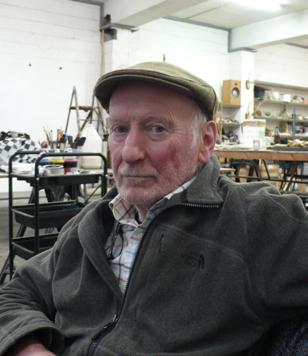
4 minute read
Report from the Studio: Artists Working Through the Pandemic
These are unprecedented times. For weeks and months, museums and galleries have been forced to keep their doors closed. Popular art events, from Grand Rapids’ own ArtPrize to the international art fair Art Basel, were cancelled. Artists were isolated and often cut off from their studio facilities and routines. With a great degree of concern, I contacted some of the artists that are represented in the permanent collection of Frederik Meijer Gardens & Sculpture Park, including Richard Hunt, Jaume Plensa, Sophie Ryder and Bill Woodrow.
The good news is that despite the COVID-19 pandemic, these artists have continued to work. Some of them have had to adjust their studio practice, others did not have to change their routine at all. I expected large-production studio work to come to a complete stop, but Richard Hunt shared with me that he still has a team of assistants who continue to fabricate large commissioned sculptures while wearing masks and taking proper precautions. They are currently working on a piece for the Art Institute of Chicago. When speaking on the phone with Mr. Hunt, I asked him specifically whether the sculpture Column of the Free Spirit, installed at Meijer Gardens in 2000, had a new significance today during the time of Black Lives Matter. Mr. Hunt said that Column of the Free Spirit was always intended to be a work that had a welcoming expression, conveying a sense of uplift and expansion. He does not consider it a work that addresses specific social issues. Mr. Hunt took a moment to remember Fred & Lena Meijer and concluded that Fred Meijer wanted everybody to be better off.
Advertisement
Jaume Plensa, whose commissioned sculpture Utopia is being installed in Meijer Gardens’ new Garden Pavilion, is based in Spain, one of the European countries hardest hit by the pandemic. Mr. Plensa has largely quarantined himself, while working on a new series of drawings, entitled April Is the Cruelest Month.
Interview and essay by Jochen Wierich, Curator of Sculpture & Sculpture Exhibitions

Richard Hunt from his recent visit to Meijer Gardens in 2019.
Jochen Wierich

Jaume Plensa in his studio.
Plensa Studio Barcelona and Richard Gray Gallery, Chicago/New York
How did you experience this time of self-isolation? How did it impact your studio practice?
Sophie Ryder: I continued working throughout isolation, in fact because I had no staff coming in, I got more work done than ever and I loved it! I worked longer hours and had a really good routine going. Not that different from normal life, as I am a bit of a hermit at the best of times—just less distraction.
Bill Woodrow: My studio is in London, but my home is 100 miles to the southwest of London. When lockdown happened, I was at home and I have not been to the studio for three months. I thought initially that this would be a somewhat challenging situation, but it has been far from that.
During this time of great uncertainty, is there something in your life that provided comfort and stability—perhaps a routine, a hobby or a work project?
SR: Our routine is the same every day. And involves lots of walks for the dogs, exercise and cooking. I started a sourdough starter to make gluten-free bread. We hatched 14 chicks from eggs and have replanted the vegetable garden.
BW: May and June are always a busy time for beekeepers, and this year especially so in the UK as the weather has been so good. This has meant that the number of hives that I have at home has increased from 2 to 5, due to an abundance of swarms that needed collecting. This has kept me busy and I find that looking after my bees is always extremely rewarding and therapeutic.
Is there any specific work that you have started or that you expect to come out of the crisis?
SR: I have made lots of work during the pandemic and one is specifically inspired by COVID-19, but is not finished yet. I have reflected on the pandemic and will produce a few pieces of work about it. It takes a while for ideas to filter through, so it could be much later. I am not really a political artist so I am not sure if I will be inspired to make work about racial discrimination. It upsets me, but I don’t feel close enough to the events to portray them. I don’t watch television or read the papers so I really don’t see current events. I do listen to the radio, so it’s not as visual. Who knows! I don’t really plan what I do, my hands just take over and I just go with the flow.
BW: Although I have been making a few small works at home, none of them have any direct connection to the current situation. Generally, I am not the kind of artist who would respond immediately in my work to any crisis. I think that my responses would be too obvious. I have noticed over my career that my responses to things have a long gestation period, and often don’t surface for a couple of years and then sometimes in a very curious and roundabout way. I think what is happening is a sorting out in my head of what is really important to me, and often a response can appear in a work without me immediately recognizing it.

Sophie Ryder in the Balk Galleries during her exhibition, Sophie Ryder, in 2007.

Sophie Ryder. Introspective, 2005. Bronze.
Dean VanDis

Bill Woodrow in his studio.
Bill Woodrow

Bill Woodrow tending his beehives.
Bill Woodrow

Bill Woodrow. Listening to History, 1995 (cast 2000). Bronze.
William J. Hebert









